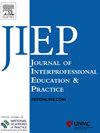The state of interprofessional education within family medicine Graduate Medical Education: A 2022 CERA survey
Q3 Social Sciences
Journal of Interprofessional Education and Practice
Pub Date : 2025-02-08
DOI:10.1016/j.xjep.2025.100738
引用次数: 0
Abstract
Background and purpose
The need for interprofessional education (IPE) to enable effective team-based care has been well-established. This study describes IPE in family medicine residency programs and identifies barriers and facilitators to IPE implementation.
Methods
Ten survey questions addressing IPE were part of a national survey of family medicine residency program directors. Statistical analysis of survey data included chi-square analyses and descriptive statistics.
Results
The response rate was 42.18 % (286/678). Nearly 83 % of program directors agreed that IPE is essential to training competent family medicine physicians. Approximately 62 % reported learning objectives pertaining to interprofessional collaborative practice. Barriers to implementing IPE included lack of time and scheduling conflicts. Facilitators included ties with other health professions training programs and leadership support.
Conclusion
This survey demonstrated interprofessional collaborative practice as a highly valued component of family medicine training; yet shows a need for deliberately designed IPE with explicit learning objectives and competency-based assessment strategies.
家庭医学研究生医学教育中的跨专业教育现状:一项2022年CERA调查
背景和目的跨专业教育(IPE)的必要性,使有效的团队为基础的护理已经确立。本研究描述了家庭医学住院医师计划中的IPE,并确定了IPE实施的障碍和促进因素。方法针对IPE的调查问题是一项针对家庭医学住院医师项目主任的全国性调查的一部分。调查资料的统计分析包括卡方分析和描述性统计。结果总有效率为42.18%(286/678)。近83%的项目主管同意IPE对培训合格的家庭医学医生至关重要。大约62%的人报告了与跨专业协作实践有关的学习目标。实施IPE的障碍包括缺乏时间和计划冲突。促进因素包括与其他卫生专业培训项目的联系和领导支持。结论跨专业合作实践是家庭医学培训的重要组成部分;然而,这表明需要精心设计具有明确学习目标和基于能力的评估策略的IPE。
本文章由计算机程序翻译,如有差异,请以英文原文为准。
求助全文
约1分钟内获得全文
求助全文
来源期刊

Journal of Interprofessional Education and Practice
Social Sciences-Education
CiteScore
1.60
自引率
0.00%
发文量
80
期刊介绍:
Journal of Interprofessional Education & Practice, a quarterly online-only journal, provides innovative ideas for interprofessional educators and practitioners through peer-reviewed articles and reports. Each issue examines current issues and trends in interprofessional healthcare topics, offering progressive solutions to the challenges facing the profession. The Journal of Interprofessional Education & Practice (JIEP) is affiliated with University of Nebraska Medical Center and the official journal of National Academies of Practice (NAP) and supports its mission to serve the public and the health profession by advancing education, policy, practice & research.
 求助内容:
求助内容: 应助结果提醒方式:
应助结果提醒方式:


